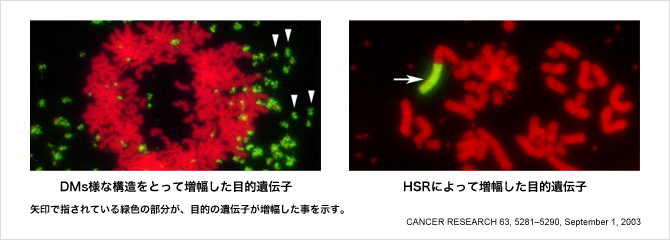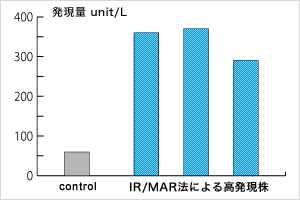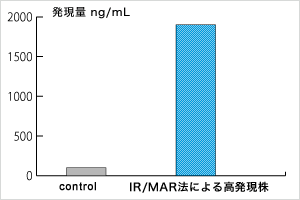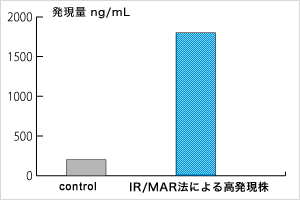Features
・ Simple and rapid construction of Hi-producer cell base on a novel mechanism of gene amplification
・ Custom production of contract service is provided
・ Reagent (ready-to-use) is also supplied
Principle
This method was discovered by Professor Noriaki Shimizu and others at Hiroshima University’s Graduate School of Biosphere Science. It introduces, into culture cells, expression plasmids and special sequences called the initiation region (IR) and the matrix attachment region (MAR). As a result, the genes contained in the expression plasmids are efficiently amplified, and assume the structure of double minutes (DMs) and form homogeneously staining regions (HSRs). Due to the many copies of the target gene produced on the genome, the amount of target protein expressed increases dramatically. This method is not limited to certain cell lines: it can produce protein hyper-producing cells based on whichever cell line you choose.

< Reference >
Cancer Res 61, 6987–6990, 2001
Plasmids with a Mammalian Replication Origin and a Matrix Attachment Region Initiate the Event Similar to Gene Amplification.
Noriaki Shimizu, Yuri Miura, Yu Sakamoto and Ken Tsutsui
Cancer Res 63, 5281–5290, 2003
Amplification of plasmids containing a mammalian replication initiation region is mediated by controllable conflict between replication and transcription.
Noriaki Shimizu, Toshihiko Hashizume, Kenta Shingaki and June-ko Kawamoto
Exp Cell Res 302(2), 233-243, 2005
When, where and how the bridge breaks: Anaphase bridge breakage plays a crucial role in gene amplification and HSR-generation.
Noriaki Shimizu, Kenta Shingaki, Yukiko Kaneko-Sasaguri, Toshihiko Hashizume and Teru Kanda
J Cell Biochem 101, 552-565, 2007
Dissection of Mammalian Replicators by a Novel Plasmid Stability Assay.
Toshihiko Hashizume and Noriaki Shimizu
Nucleic Acids Research, 39(3), 958-969, 2011
Amplification of a plasmid bearing a mammalian replication initiation region in chromosomal and extrachromosomal contexts.
Saiyu Harada, Naoki Sekiguchi, and Noriaki Shimizu
Protein Expression and Purification 80, 41-46, 2011
High-level expression of human recombinant cyclooxygenase-1 in mammalian cells using a novel gene amplification method.
Hiromitsu Yoshimura, Shingo Sekine, Hisashi Adachi, Yoshikatsu Uematsu, Akiko Mitani, Nobuko Futaki, Noriaki Shimizu
PLoS one, 2012
Efficient Recombinant Production in Mammalian Cells Using a Novel IR/MAR Gene Amplification Method
Yoshio Araki, Tetsuro Hamafuji, Chiemi Noguchi, Noriaki Shimizu
Practical Examples
When HEK293 was used (at our company)

We introduced about 8.5 kbp of genes together with the IR/MAR sequence, produced a protein hyper-producing cell line and cloned it.
The proteins produced possessed activity, and it was found that the hyper-producing cell line’s production of proteins that possess activity was more than 6 times that of the control, which did not contain the IR/MAR sequence.
When CHO cells were used
(data provided by Professor Noriaki Shimizu of Hiroshima University’s Graduate School of Biosphere Science)

Antibody genes were introduced together with the IR/MAR sequence, and a hyper-producing cell line was produced. It was found that the hyper-producing cell line produced more than 30 times as many antibodies as the control, which did not contain the IR/MAR sequence.
When COLO320DM cells were used
(data provided by Professor Noriaki Shimizu of Hiroshima University’s Graduate School of Biosphere Science)

Antibody genes were introduced together with the IR/MAR sequence, and a hyper-producing cell line was produced. It was found that the hyper-producing cell line produced more than 8 times as many antibodies as the control, which did not contain the IR/MAR sequence.
Prices
Contract service
| Process | Content | Standard Period | Price |
|---|---|---|---|
| Total | JPY1600,000~ (JPY900,000~) |
||
| 1. Transfection | ・ Co-transfection (expression vector and TG-Sure expression) ・ Selection for drug resistance, and polyclonal production |
6-8 weeks | JPY800,000~ (JPY450,000~) |
| 2. Isolation of clones of hyper-producing cells | ・ Cloning ・ Confirmation of gene amplification or production |
6-8 weeks | JPY800,000~ (JPY450,000~) |
*( ) shows a special prices for academic customer.
*Please inquire about expression-cell culture and protein purification.
*Adaptation of suspension culture (CHO cell line) is also available.
Reagent
| Product | Volume | Price | Data-sheet | License agreement |
|---|---|---|---|---|
| TG-Sure Expression(IR/MAR) | 10 μg | JPY112,500 | |
|
*Co-transfection with this DNA reagent and expression vector into host cell line, gene-amplified clone is obtained.
*The use of this product is strictly limited for research purpose only in the organization that purchaser is belonged.
*The purchaser should not make copies of this product. The purchaser should not transfer and/or resell copies and/or derivatives of this product to any third parties.
*Use of the product and the results (i.e. expression cell and protein) for any commercial purpose requires
a commercial license agreement between TransGenic Inc. and the purchaser.
*In the case of order, please check the License statements and submit the signed License Agreement to
TransGenic Inc. via distributor.
dhfr/MTx Gene Amplification Method
Features
・Carried out with the CHO/DG44 cell line, derived from the Chinese hamster ovary and used in pharmaceutical manufacturing
・MTx concentration can be increased to 1-5μM, and we deliver stably expressing cell lines
・From order to delivery takes 3-5 months
Principle
Derived from the dihydrofolate reductase-deficient Chinese hamster ovary cell, CHO/DG44 is a cell line that requires thymidine and hypoxanthine in the culture medium. The dhfr gene and the target gene are both introduced into this cell line. Adding DHFR’s competitive inhibitor, methotrexate (MTx), in incremental steps amplifies the target gene, making it possible to obtain hyper-producing cells. This is one of the methods most frequently used in the production of pharmaceuticals.
Practical Example (carried out at our company)

An antibody gene and a sequence containing DHFR were both introduced, and the MTx concentration was increased to 1,000 nM in incremental steps. The MTx concentration was increased to 1,000 nM in incremental steps. The amount of protein produced increased to more than 40 times that prior to processing. It took about 20 weeks to increase the concentration to 1,000 nM and carry out the culturing.
Prices
| Process | Content | Standard Period | Desired Retail Price |
|---|---|---|---|
| Total | From 1,600,000 yen | ||
| 1. Transfection and MTX selection | ・Co-Transfection(Expression vector and dhfr vector) ・Selection for Tymidine/Hypoxanthine ・Gene amplification by MTX (1-5micro M) addition |
12-20 weeks | From 800,000 yen |
| 2. Isolation of clones of hyper-producing cells | ・Cloning ・Confirmation of gene amplification or protein production |
8-12 weeks | From 800,000 yen |
